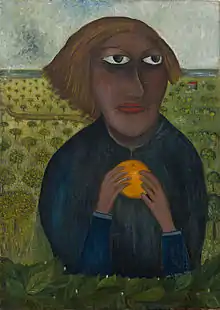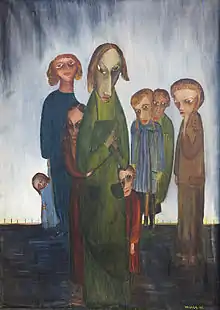Lette Valeska
Lette Valeska (August 20, 1885 – January 8, 1985) was a photographer, painter and sculptor in the Hollywood community. When her husband's chemical plant was confiscated by the Nazi regime, she left her homeland of Germany and traveled with her husband and daughter before moving to New York City in 1937. In 1938 she left her husband and moved to Los Angeles, where she spent the rest of her life.[1] She began a photographic career of children's portraits and quickly gained notoriety among Hollywood stars. She worked as an archivist for the Pasadena Art Museum's Blue Four Collection.[2] At the end of World War II, she organized a friendship correspondence between children in California and Ryswyck, Holland out of gratitude for Ryswyck citizens' assistance to holocaust refugees. At age 50, Valeska began painting and at age 70 began sculpting. She was featured in the Emmy award winning NBC documentary "The Heart Is Not Wrinkled" in 1969.[1]
Lette Valeska | |
|---|---|
 The Promised Land self-portrait by Lette Valeska, date unknown. | |
| Born | Valeska Heinemann August 20, 1885 Braunschweig, Germany |
| Died | 8 January 1985 (aged 99) |
| Other names | Valeska Heinemann |
| Occupation | Artist |
| Spouse(s) | Ernst Heyman |
Valeska's photographs were always taken at her subjects' homes rather than a studio, a method she used to capture real people alive in their own environments.[3] Never having been formally trained as an artist, her artwork expresses her soul rather than technical proficiency.[4] Valeska and Galka Scheyer are credited with introducing German Expressionism to the Southern California art scene through her work with the Blue Four.[2]
Early life
Valeska Heinemann was born in Braunschweig, Germany, to the owners of a department store.[3] Although she was of Jewish heritage, her family was assimilated into German society and she had little interest in her roots during her youth.[5] She attended a girls school from 1891 to 1901, after which she studied English, French and Italian language and literature for eight years with private tutors.[1] She began experimenting with photography at age 12 and carried a camera everywhere she went.[5]
From 1911 to 1914 she worked as a German language secretary for an engineering magazine in Brussels, Belgium. After returning to Braunschweig and back to Brussels, she married Ernst Heyman, the owner of a chemical factory in Frankfurt in 1920. They lived in Frankfurt with their daughter, Hella, until 1932, when the family moved to Paris.[1] The Nazis confiscated the chemical factory a year later, but Ernst opened another branch of the factory, which funded their travels to Palestine and throughout Europe.[3] In 1937 Valeska, Ernst and Hella emigrated to New York. A year later, Valeska and Ernst separated and Valeska moved to Los Angeles at the request of her childhood friend, Galka Scheyer.[2]
Photographic career
Shortly after Valeska arrived in Los Angeles, she secured permission to photograph children at UCLA's elementary school for education purposes. She created her own exhibit for parents and teachers in 1939, and later her photographs were used to illustrate the school's nursery and kindergarten education program to educators throughout California.[5]
Valeska's photographs of schoolchildren captured the attention of Los Angeles. Mrs. David Selznick asked Valeska to photograph a day in her children's lives, and her husband was so impressed that he commissioned her to photograph Hollywood stars.[3] This launched her into a career of photographing celebrities and their families at home, including Elizabeth Taylor, Gregory Peck, Mickey Rooney, Rita Hayworth, Jennifer Jones, James Stewart, Rhonda Fleming, Joseph Cotten, Natalie Wood and Margaret O'Brien.[1][3][5] Valeska led several other photography projects. In 1942, the California Department of Education assigned Valeska to photograph a typical day in a one-room rural school for member nations of the Inter-American educational conference.[1] In 1951, the Council of Jewish Federations of Greater Los Angeles requested that she photograph Israel's destitute for refugee relief fundraisers.
In December 1941, Valeska's photographic career was interrupted when the US government confiscated her cameras because she was not a US citizen. The principal of UCLA's elementary school and other individuals familiar with Valeska's work wrote letters to the attorney general vouching for her support of the US government and requesting the return of her cameras. The cameras were returned shortly, but with restrictions upon their use.[5]
In November 1945, at the end of World War II, Valeska established a friendship campaign between the children of Los Angeles and Ryswyk, Holland, a town whose residents protected her friends and other Jews from the Holocaust. She contacted the mayor of Ryswyk and received the names and addresses of the city's children.[5] The campaign started at the UCLA elementary school, whose students "adopted" children in Ryswyk and sent them letters, clothes and food.[6] Soon children throughout Los Angeles were encouraged to participate in the campaign, and over 2,000 children in Ryswyk received packages. Other American cities were inspired by this program and established their own friendship campaigns with other European cities affected by the war.[5] In 1950, Valeska visited Ryswyk where she was greeted by parades and ceremonies and titled "The Mother of Ryswyk".
Painting and Sculpture Career

Galka Scheyer encouraged Valeska to begin painting in 1939, at the age of 54, despite the fact that she had no formal training.[1] Scheyer had been teaching children to paint spontaneously and expressively, and she welcomed Valeska's inexperience with the medium. Valeska developed her own painting style, characterized by elongated faces and richness in color and detail, although some paintings are muted and somber. Her art depicts Jewish religious motifs and Jewish suffering, although she had grown up removed from these religious and cultural experiences.[7] Her relatives' and her own experiences with the Nazi regime motivated her to rediscover her Jewish roots. When she moved to Los Angeles, she studied Jewish history and literature, joined the Los Angeles Hadassah chapter and participated in other Jewish organizations.[8] Valeska claimed that themes for her paintings were "born unconsciously" from a greater force, however.[5] Her paintings have appeared in gallery exhibitions including her own one-woman show at the La Tortue gallery in Santa Monica in 1970.[9]
Valeska began sculpting with clay in 1955 at the age of 70 with the guidance of Jane Ullman, a sculptor. She had no formal training in this medium either, and she continued to depict Jewish themes in her sculpture.[5] Her sculpture was exhibited at Brandeis University in 1966 and alongside her paintings and photographs in a one-woman show at the Los Angeles Jewish Community Building in 1980, among other venues.[1][10]
References
- For Valeska Catalogue: Biography. Burbank, CA: Bob Suhosky Associates.
- Horn, Virginia (20 Aug 1965). "Lette Valeska---Richness of Creativity". Los Angeles Times (Print). pp. V3.
- Flake, Kolma (Sep 1945). "Arrested Moments". Minicam Photography. 9 (1): 50–55.
- Coale, Marti (Feb–Mar 1971). "The Heart Is Not Wrinkled". Modern Maturity. 14 (1): 22.
- Ronnie, Art (1970). "Don't Compare Her to Grandma Moses". Los Angeles Herald-Examiner (Print).
- McDonald, Catherine (1 Jan 1946). "Little Miss Somebody". The Villager.
- Green, L. C. (6 Jan 1950). "Valeska". The American Hebrew (Print). pp. 5, 12–13.
- Mira Hamermesh; Otto Zarek (21 May 1950). "Paintings of the Ghetto". Zionist Review. pp. 13–15.
- N.a. (28 Jul 1970). "Art by the Brush". The Daily Sun-Post. p. 6.
- "Valeska, at 95, Painting Like 'A Child at Play'". JFC Bulletin. 10 Mar 1980.
External links
![]() Media related to Lette Valeska at Wikimedia Commons
Media related to Lette Valeska at Wikimedia Commons